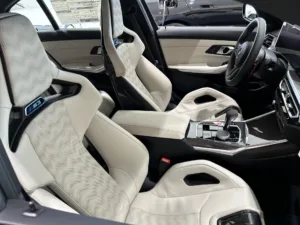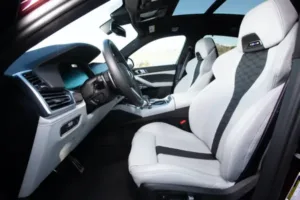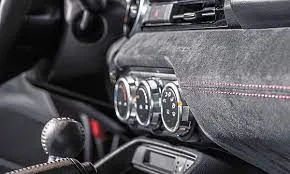News
Car Detailing at Home vs. Professional Services: What’s Best for Your Vehicle?
Part 1: The Allure of DIY Car Detailing
Car culture has always thrived on a deep sense of connection between the driver and the machine. From weekend enthusiasts polishing their pride and joy in the driveway to meticulous collectors restoring every inch of their classic icons, there is something almost therapeutic about taking care of a car yourself. This is where the allure of do-it-yourself (DIY) car detailing begins. It is more than just washing a vehicle; it is about the satisfaction of seeing your own effort transform the appearance of your car. In this section, we’ll explore why so many car owners are drawn to DIY detailing, what it actually involves, the tools and products that make it possible, its many benefits, and the potential downsides that often remain hidden until it’s too late.
The Emotional Pull of DIY
For many drivers, DIY car detailing isn’t just about saving money. It’s about pride of ownership. There is a unique satisfaction in standing back after a long day of cleaning, waxing, and polishing, knowing every bit of shine was created by your own two hands. Unlike taking a vehicle through an automatic car wash or dropping it off at a detailing shop, DIY detailing feels more personal. You are not only cleaning your car but also bonding with it, learning its lines, noticing its imperfections, and addressing them with care.
This emotional connection is what makes DIY detailing so appealing. A Saturday morning spent with a bucket, hose, microfiber towels, and a bottle of wax isn’t just maintenance—it’s a ritual. Many car enthusiasts describe it as meditative. The slow, methodical movements of clay barring or hand-waxing allow them to disconnect from the pressures of daily life and focus solely on their vehicle.
Accessibility of Tools and Products
The rise of affordable detailing products has fueled the DIY movement. Decades ago, most advanced cleaning and protection products were reserved for professionals. Today, anyone can order high-quality waxes, ceramic sprays, foam cannons, and microfiber cloths online. Even orbital polishers, once considered specialist tools, are widely available for consumer use at reasonable prices.
Modern car care brands have tapped into this market with user-friendly products. Waterless wash sprays, quick detailers, and all-in-one polishes are designed to deliver professional-like results without requiring years of training. The accessibility of information has also played a huge role. YouTube tutorials, detailing forums, and step-by-step blogs allow enthusiasts to learn techniques once known only to professionals. With this knowledge and a relatively small investment, many car owners feel empowered to handle their own detailing.
Cost Savings and Financial Appeal
One of the strongest practical reasons people turn to DIY is cost. A full professional detailing service can range anywhere from $150 to over $1,000 depending on the level of service and the condition of the car. For someone who washes their car regularly, those costs add up quickly.
DIY detailing allows owners to invest once in tools and products that can be reused many times. A quality orbital polisher may cost a few hundred dollars, but it can last for years. Bottles of shampoo, wax, and protectants stretch across multiple applications. For budget-conscious drivers, this makes detailing at home an attractive proposition. Over time, the cost per session can drop to a fraction of what a professional would charge.

Flexibility and Control
Another advantage is flexibility. DIY detailing lets you set your own schedule. You don’t need to book appointments, drive to a detailing shop, or wait for hours while the work is done. You can decide to wash your car on a sunny afternoon or polish it late at night under the garage lights.
Control is another factor. When you detail your car yourself, you decide which products to use, which areas to focus on, and how much time to spend on each step. Some car owners feel that professional shops rush through services or use generic products. Doing it yourself gives you the peace of mind that your vehicle is being cared for exactly the way you want.
The Learning Curve and Common Mistakes
Despite the appeal, DIY detailing comes with a steep learning curve. Washing a car seems simple enough, but true detailing involves more advanced techniques. Polishing, paint correction, and ceramic coating require skill, patience, and a keen eye for detail.
Common mistakes include:
Using the wrong cloths: Old bath towels or cheap rags can scratch clear coat.
Improper washing methods: Circular scrubbing with a sponge traps dirt and grinds it into paint.
Over-application of products: Too much wax or polish can create streaks and residue.
Lack of preparation: Skipping steps like claying leads to contamination sealed under wax.
Using harsh chemicals: Household cleaners like dish soap strip wax and damage paint.
These errors often go unnoticed until damage accumulates. Swirl marks, etched paint, and faded trim are common signs of improper DIY care. Unfortunately, fixing these mistakes usually costs far more at a professional shop than a simple preventative service would have.
Case Examples: Successes and Failures
To illustrate, consider the story of Jake, a weekend car enthusiast. He invested in a dual-action polisher, quality microfiber towels, and a reputable ceramic spray coating. With hours of patience and guidance from online tutorials, Jake transformed his daily driver from a dull, weathered sedan into a gleaming machine that looked showroom-fresh. The sense of achievement he felt each time he walked to his car in the morning made the effort worthwhile.
On the other hand, there’s Lisa, who attempted to save money by polishing her car with a drill attachment buffer and an inexpensive compound she found at a big-box store. Without proper technique, she left holograms across the paint and even burned through clear coat in one area. What was supposed to be a cost-saving DIY project turned into a $1,200 professional repaint.
These examples highlight the duality of DIY detailing—it can be immensely rewarding when done right, but costly and frustrating when mistakes are made.
The Hidden Costs of DIY
While DIY is often praised for saving money, hidden costs exist. Time is the biggest one. A thorough detail, including wash, clay, polish, and wax, can take six to eight hours or more for a beginner. Professionals complete the same process in half the time with superior results. For those with busy schedules, the opportunity cost of spending an entire weekend on car care is significant.
There is also the cost of mistakes. Buying cheap products to cut corners often leads to disappointing results and wasted money. Conversely, investing in high-end products narrows the cost gap between DIY and professional services. Storage space for tools and products is another hidden factor—detailing gear takes up room in the garage or home.
The Intangible Benefits: Mindset and Connection
Despite the risks and effort, many enthusiasts swear by DIY detailing because of the intangible benefits. Detailing a car yourself fosters a deeper appreciation for the vehicle. You begin to notice subtle details—a tiny chip in the paint, a faint scratch, the way light reflects off polished curves. These observations often lead to a stronger bond between driver and machine.
DIY detailing also nurtures patience and discipline. The meticulous nature of cleaning every crevice and buffing every panel teaches focus. It’s not unusual for detailers to describe their work as a form of therapy—an escape from screens and stress, replaced by the tactile satisfaction of working with your hands.
When DIY Works Best
DIY detailing is particularly effective for routine maintenance. Regular washes, interior vacuuming, tire dressing, and quick waxes can easily be handled at home with minimal risk. It’s also ideal for car owners who enjoy the process and see it as a hobby rather than a chore.
For vehicles that are not in show condition or are primarily used as daily drivers, DIY can maintain appearance and protect value without requiring frequent professional intervention. However, for tasks like deep paint correction, ceramic coating, or interior restoration, professional expertise often provides better long-term outcomes.
Conclusion of Part 1
The allure of DIY car detailing lies in its accessibility, cost savings, and personal satisfaction. It offers car owners a hands-on way to care for their vehicles while developing a stronger bond with them. Yet, it is not without its risks. The lack of training, improper tools, and overlooked details can turn well-intentioned efforts into expensive mistakes. As we transition to Part 2, we will shift focus to the professional side of the equation—what detailing experts bring to the table, why their services carry value, and how they differ from even the most dedicated DIY efforts.
Part 2: The Professional Advantage
When most people think of car detailing, they often picture someone with a bucket of water, a sponge, and maybe a vacuum cleaner for the inside. But professional detailing is a very different world altogether. It is an industry built on expertise, precision, and advanced techniques that go far beyond the capabilities of most DIY enthusiasts. In this section, we’ll dive into what professional detailing really means, the tools and technology that set it apart, the expertise that professionals bring, the long-term benefits that customers gain, and the scenarios where choosing a professional service makes the most sense.

What Professional Detailing Really Entails
Professional detailing is often misunderstood. Many people assume it’s simply a glorified car wash. In reality, it’s a comprehensive service that restores, protects, and enhances a vehicle to a level that is often superior to factory condition.
A typical professional detail may include:
Exterior wash and decontamination with pH-balanced shampoos, iron removers, and clay bar treatment.
Paint correction to remove swirl marks, scratches, oxidation, and water spots using machine polishers and graded compounds.
Protective coatings such as wax, sealants, or ceramic coatings that can last months or years.
Interior detailing that goes beyond vacuuming to include steam cleaning, leather conditioning, carpet shampooing, and odor neutralization.
Wheels and brake care, involving removal of brake dust, polishing of rims, and protection against corrosion.
Engine bay cleaning, done carefully to avoid electrical damage while removing built-up grime.
This is a far cry from a 20-minute drive-through wash. Professional detailing treats a car holistically, inside and out, and tailors each service to the specific needs of the vehicle.
Advanced Tools and Technology
One of the defining differences between DIY and professional detailing is access to specialized tools. Professionals invest thousands of dollars into equipment that most car owners would never purchase for home use.
Dual-action and rotary polishers: These machines correct paint imperfections with controlled power and precision. In untrained hands, they can damage paint, but professionals use them to achieve mirror-like finishes.
Steam cleaners: Capable of sanitizing interiors, killing bacteria, and cleaning delicate surfaces without harsh chemicals.
Hot water extractors: Used for deep-cleaning carpets and upholstery, pulling out dirt, oil, and odors trapped deep within fibers.
Lighting systems: Bright, color-corrected lights reveal paint imperfections invisible in normal conditions, ensuring every flaw is addressed.
Air tools: High-pressure air guns and vacuums help clean tight spaces like vents, switches, and seams.
Alongside these tools, professionals use premium-grade products—many of which are unavailable to the public. Professional ceramic coatings, for instance, often require certification to apply because of their complexity and durability.
Expertise and Experience
Tools alone don’t guarantee results. What truly distinguishes professional detailers is their expertise. Years of hands-on experience teach them how to handle different types of paint, fabrics, plastics, and leathers. They understand how different chemicals interact with surfaces and how to adapt techniques for each unique car.
For example, correcting paint on a vintage Porsche requires a very different approach than detailing a brand-new Tesla with a delicate clear coat. Professionals know how to minimize risk while maximizing results. They can evaluate whether a scratch is shallow enough to be polished out or deep enough to require touch-up paint. They know how to treat leather without over-conditioning or cracking it.
This level of expertise is difficult to replicate from YouTube tutorials alone. Professional detailers combine art and science, balancing meticulous care with efficiency.
The Value of Time and Convenience
One of the most overlooked benefits of professional detailing is time. As mentioned in Part 1, a full DIY detail can take an entire day—or even a whole weekend—for an enthusiast. Professionals, with their tools and expertise, can deliver equal or better results in a fraction of that time.
For busy professionals, parents, or anyone with limited free hours, outsourcing this task provides peace of mind. Instead of spending a Saturday claying and polishing, you can drop off your vehicle in the morning and pick it up in the afternoon looking like new. Some mobile detailers even come to your home or office, adding another layer of convenience.
Long-Term Benefits for Your Vehicle
Professional detailing isn’t just about immediate shine—it’s about long-term preservation. The benefits extend far beyond aesthetics.
Paint Protection: Properly applied wax, sealant, or ceramic coating shields the paint from UV rays, oxidation, acid rain, and bird droppings. This prevents fading and extends the life of the paintwork.
Resale Value: A well-maintained car commands a higher price on the used market. Buyers are more likely to pay a premium for a vehicle that looks cared for inside and out.
Interior Longevity: Professional cleaning and conditioning keep leather supple, fabrics stain-free, and plastics from cracking. This preserves the feel and smell of a car’s interior.
Mechanical Health: Engine bay cleaning can prevent buildup that leads to overheating or corrosion. Clean wheels reduce brake dust corrosion.
Peace of Mind: Knowing your car is protected reduces anxiety about wear and tear, letting you enjoy it more.
These benefits accumulate over time. A car detailed professionally on a regular schedule may retain thousands of dollars more in value than one that is only casually washed.
Costs Versus Value
Of course, professional detailing comes at a cost. Depending on location and level of service, prices range from $150 for a basic package to $2,000 or more for multi-stage paint correction and ceramic coating.
At first glance, this may seem excessive compared to DIY. But when viewed through the lens of value, the cost makes more sense. Consider the following:
A ceramic coating costing $1,500 may protect your paint for five years, saving you from needing frequent waxing and preserving resale value.
Regular $200 details may prevent thousands in depreciation when you decide to sell.
Avoiding mistakes like paint burns or interior damage saves costly repair bills.
In many cases, the value of professional detailing outweighs the price, especially for high-end or collectible vehicles. For daily drivers, the calculation depends on how much the owner values appearance, convenience, and preservation.
Scenarios Where Professionals Shine
While DIY works for basic upkeep, there are scenarios where professional services clearly excel:
Paint Correction: Removing deep swirls, scratches, and oxidation is extremely difficult without advanced machines and training.
Ceramic Coating or PPF Installation: These require controlled environments, precision, and certified products.
Luxury or Classic Cars: Vehicles with unique finishes or high market value benefit from expert care.
Selling a Vehicle: A professional detail before listing can dramatically improve sale price and buyer interest.
Neglected Cars: Vehicles with years of built-up dirt, stains, and damage need professional intervention for proper restoration.
In these cases, the cost of professional detailing is not only justified but often essential.

The Psychological Edge
Another factor that often goes unnoticed is the psychological benefit. Many car owners report feeling more pride and joy in their vehicles after professional detailing. Driving a freshly detailed car feels different—it creates a sense of luxury and newness that DIY sometimes struggles to replicate.
There’s also the confidence of knowing a professional handled the work. Instead of second-guessing whether you polished correctly or applied enough product, you can relax knowing the job was done to a high standard. For some, this peace of mind is worth as much as the physical results.
The Limitations of Professional Services
To keep the comparison fair, it’s important to acknowledge that professional detailing isn’t perfect. Costs can be prohibitive, especially for frequent detailing. Not all detailers are equally skilled—some shops cut corners, use cheap products, or rush jobs. Finding a reputable professional takes research, reviews, and sometimes trial and error.
Additionally, professional services lack the emotional satisfaction of DIY. For enthusiasts who love the process of working on their cars, outsourcing everything removes that personal connection. Some owners prefer to do basic maintenance themselves, using professionals only for advanced tasks.
Conclusion of Part 2
Professional detailing offers clear advantages: advanced tools, expertise, convenience, and long-term value that far surpasses what most DIY efforts can achieve. For those who see their car as more than just transportation, investing in professional services preserves not only the vehicle’s condition but also the pride of ownership. Still, the high costs and lack of personal involvement mean professional detailing is not the right choice for everyone in every situation.
As we move into Part 3, we’ll explore how to strike the right balance—how car owners can combine the best of both worlds by maintaining a routine of DIY care while relying on professionals for specialized services. This hybrid approach often provides the optimal mix of cost savings, satisfaction, and vehicle longevity.
Beyond the tangible outcomes, professional detailing also represents an investment in mindset. When you commit to regular services, you adopt a philosophy of preventative care rather than reactive fixes. Instead of waiting until the paint is dull or the interior is worn, you stay ahead of problems, preserving your car’s condition for the long run. This habit mirrors the way enthusiasts maintain performance parts, schedule oil changes, or monitor tire health—it’s about treating your vehicle as something to be cared for proactively, not just reactively.
Moreover, professional detailers often act as advisors. A trusted detailer may recommend when it’s time for a new sealant, which areas of the car are showing early signs of wear, or what products work best for your climate and driving style. This guidance extends the relationship beyond service into mentorship, helping owners become more informed caretakers of their cars.
Ultimately, the value of professional detailing is not just the immediate sparkle when you pick up your car—it’s the confidence that you are preserving its beauty, functionality, and resale potential over years. And while it may not replace the pride of DIY, professional care offers something equally valuable: consistency, expertise, and peace of mind.

